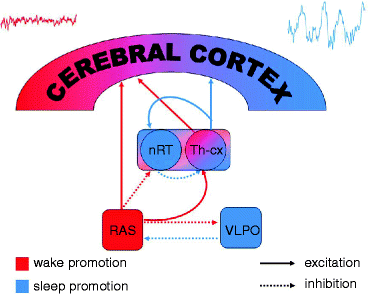and Róbert Bódizs2
(1)
Institute of Experimental Medicine and Institute of Neuroscience, Budapest, Hungary
(2)
Semmelweis University Institute of Behavioral Science, Budapest, Hungary
Abstract
In this book, we provide a new approach to sleep regulation, incorporating the new knowledge of use-dependent homeostatic regulation associated with plastic changes during NREM sleep. We amalgamated this homeostatic regulation with the line of the parallel developed by microstructural dynamics driven by sensory impulses from the surrounding world. One of the main lines in the book is the recognition of input-dependent (reactive) slow wave activity (responses) incorporated as “instant” homeostatic regulation in the slow wave homeostatic process. Consequently, we have shown the state dependency of sleep or arousal promoting effect of sensory input during NREM sleep, and the interdigitation of micro- and macro-level of sleep dynamism. This may explain how the sleeper is kept in contact with the surrounding world, preserving the continuity of sleep.
9.1 Summary
In this book, we provide a new approach to sleep regulation, incorporating the new knowledge of use-dependent homeostatic regulation associated with plastic changes during NREM sleep. We amalgamated this homeostatic regulation with the line of the parallel developed by microstructural dynamics driven by sensory impulses from the surrounding world. One of the main lines in the book is the recognition of input-dependent (reactive) slow wave activity (responses) incorporated as “instant” homeostatic regulation in the slow wave homeostatic process. Consequently, we have shown the state dependency of sleep or arousal promoting effect of sensory input during NREM sleep, and the interdigitation of micro- and macro-level of sleep dynamism. This may explain how the sleeper is kept in contact with the surrounding world, preserving the continuity of sleep.
Our scenario for the dynamic NREM sleep regulation can be summarized as follows: The homeostatic regulation is fed by the synaptic potentiation during the day providing a demand for producing slow waves, allowing synaptic decay. This is the main force of NREM sleep. When the homeostatic pressure is high, it drives the hypothalamic sleep-promoting neurons to high level of firing. The high firing rate of these neuronal assemblies keeps the wake-promoting arousal systems under inhibition. The inhibition of the arousal system liberates the thalamic burst-firing system which produces spindling and slow wave oscillations (Fig. 9.1). In this condition, sensory input fuels phasic slow wave activity reflected by the CAP A1 phases, providing slow wave injections to each perturbation of sleep (instant homeostatic regulation) during the “D” slopes characterized by high homeostatic pressure. During the decrease of homeostatic pressure (synaptic decay), the firing of the VLPO falls gradually down the impinging sensory input from the external world, reflected by CAP A2–3 phasic events, it starts to bring the sleeper to higher and higher level of arousal along the “A” slope preparing the next REM sleep (Fig. 9.2).










